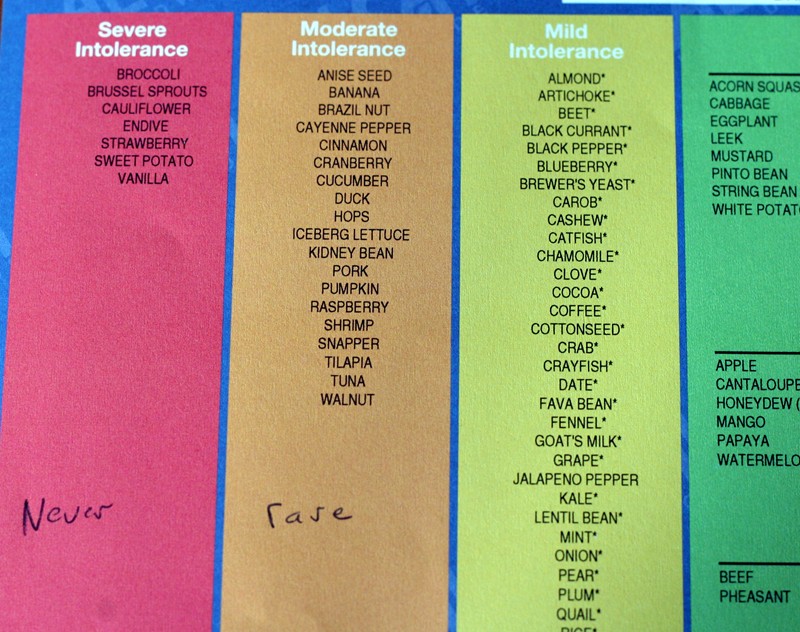ALCAT-Test
The ALCAT test ( english Antigen Leukocyte Cellular Antibody Test) or Leukozytenaktivierungstest on immunostimulants as cellular allergen stimulation test one inserted in alternative medicine diagnostic method for qualitative determination of food intolerances. It is based on the hypothesis that food intolerances can be caused by an inflammatory reaction to certain foods. By measuring the response of the patient's blood to a variety of food preparations and food additives, the patient is suggested which should avoid foods it. The method and its validity is not scientifically substantiated.
Historical
The ALCAT test is a development of the late 1950s of Blackund Bryan developed as cytotoxic food test (english test leucocytotoxic or Bryan's test) indicated tests. " Bryan's test " is based on the microscopic assessment of activation -induced changes and autolysis of leukocytes after mixing the blood with allergens and food extracts. He was due to unusable for detecting allergies. denied approval in the United States. However, a distinction was not so strictly between the different types of allergic reactions before 1975.
Biological Basis
ALCAT the method is based on an activation -induced change in size of the leukocytes or granulocytes after mixing of the blood of patients with food extracts. The underlying mechanisms have been described, inter alia by Hurd and Hashimoto and examined in detail by Grinstein et al.
The Alcat test is therefore an in vitro assay for the detection of an immune response against the antigens tested in whole blood, in which case the activation of leukocytes, in particular neutrophils, after incubation of the blood is determined with the purified extract of the food. This activation is accompanied, among others, with a change in size of the cells. Neutrophils carry on their surface IgG and IgA receptors to which antibodies bind with their Fc portion. Bind specific antigens to antibodies, the cells are activated. As far as the activation of the cells is caused by IgG antibody, it must be assumed that this is mainly antibodies of isotypes IgG1 and IgG3 are. Since neutrophils do not wear IgE receptors, classic IgE -mediated type I allergies are not covered by the ALCAT test and should therefore be excluded in advance by appropriate testing procedures.
Technical
The implementation of the actual reaction takes place in standardized, prefabricated and assembled with the test substances test cassettes. The measurement then is carried out automatically in a modified measuring system on the basis of the Coulter cell counter. The reaction strength is calculated by taking the difference of the individual measurement curves against negative controls.
Costs
The test is available as a self-pay power at a cost of 50 € to 500 €, which are not covered by statutory health insurance in Germany.
Conventional diagnosis of food allergies and intolerances
Food allergies of the immediate type are usually detected by an IgE antibody tests with simultaneous positive oral provocation test. If there is clinical suspicion of a type IV allergy atopy patch test or is performed ( contraindications ) of the lymphocyte transformation test.
Allergen -specific antibody isotype G can be detected both in sera from healthy and atopic individuals. The formation of allergen-specific antibodies of the immunoglobulin classes IgG is part of the normal immune response to a foreign substance or food exposure. There is no correlation to clinical pathology with the immediate allergic type reaction. With regard to their disease relevance, the importance of the antibody is completely unsecured.
The classical method for the detection of food intolerance is a multi -week low-allergen diet followed by gradual provocation with either individual foods or so called " Supermeals ", in which a large quantity of a selection of ( pseudo-) is taken allergens. The process is very time consuming and therefore applicable only to identify a limited number of antigens ..
Evaluation of the ALCAT tests
The ALCAT procedure must be classified as a controversial method. In addition to the very complex process of elimination diet followed by challenge ( see above), there is no established, sufficiently occupied with clinical trials process to determine food intolerances. These problems are, however, also due to the nature of things. Clinical trials, which would allow a clear statement for or against the ALCAT test stand from. In addition, it is frequently found that the test would be unsuitable for determining a food allergy, but this does not the aim of the procedure.
According to Jörg Kleine- Tebbe and others is the " formerly known as cytotoxic food testing ALCAT test of food or additives ... for the diagnosis of NMA or NMI unsuitable " (NMA: food allergy; NMI: food intolerance ).
The German Society for Allergology and Clinical Immunology ( DGAI ) and the Medical Association of German Allergists (ADA ) stated the test for clarification or to rule out a food allergy inappropriate.
Potter et al stored in a short letter to the South African Medical Journal is its negative opinion about the ALCAT test and reasoned that the small number of existing studies to the test procedure.










